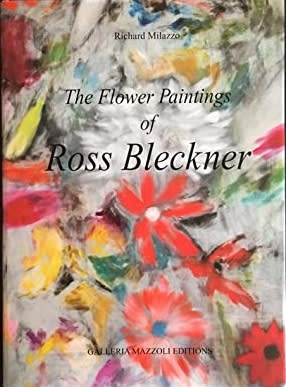The Flower Paintings of Ross Bleckner by Richard Milazzo is the most comprehensive study of the artist’s work since the author’s monograph, The Paintings of Ross Bleckner, was published in Brussels in 2007, and since the catalogue for Bleckner’s retrospective exhibition at the Solomon R. Guggenheim Museum in New York in 1995.
“Why analyze the floral portion of Bleckner’s work,” the author asks, “considering the diversity of his vision and his non-signature style? Because they become a primary and recursive part of his work, and because he sees the flower as the figure that most closely embodies the relation between mortality and the human condition. It is this ‘figure,’ perhaps even more than his infamous stripes, cells and birds, that will come to exemplify the relation between darkness and light, abstraction and figuration, and ultimately, epitomize the psychological object of desire, the flower’s fragility and transience, as such, appealing most of all to him.”
The flowers in Bleckner’s work have always been, from the very beginning, a ‘vehicle’ to explore this object or ‘tenor’ of transformation. The metaphor at work in the paintings is that of mortality, and the working method, that of methodological and metaphysical doubt. From the early ‘still lifes’ and sublime ‘landscapes’ of the Constructivist and Suprematist period, from 1976 to 1983, to the subtlest or symbolic, and sometimes kitsch, functions of the Memorial (or Commemoration) paintings and the Examined Life series, from 1985 to 1991; from the expressive immediacy of the classical Flower or Hothouse paintings, including the Yellow and Black series, from 1992 to 1997, to the lyrical and ‘documentary’ continuities of the Cell-influenced Inheritance paintings of the new millennium, from 2003 to 2006; from the more structural and spiritual continuities of the Meditation paintings to the rawest of temporalities in the most recent floral series, the Time (or Clock) paintings, from 2006 to 2010, “flowers have functioned basically within the context of a transformational ethos.”
In Bleckner’s art, the evolution of the flower will follow a very specific trajectory: depending upon light as a source of energy (photosynthesis), they (the ‘organisms’ or objects of desire) will manifest themselves as pure forms or streams of light (the stripes), evolve into light sources (chandeliers and stars) that will transform themselves into flowers, and then, into cells, and later, into abstract or floral forms of light. The Flower Paintings of Ross Bleckner documents a journey that will carry us through the late works of such artists as Goya, Turner, Monet, de Kooning, and especially, the last flower paintings of Manet, as well Velásquez, Sargent, Malevich, Nolde, Mondrian, Guston, Burchfield, O’Keeffe, Mitchell, Smithson, and such contemporaries, as Twombly, Marden and Kiefer, to the very heart of Bleckner’s work.
Ross Bleckner
The Flower Paintings of Ross Bleckner, 2011
Hardcover
Publisher: Emilio Mazzoli Editore.
Dimensions: 33 x 24 cm
Pages: 460

